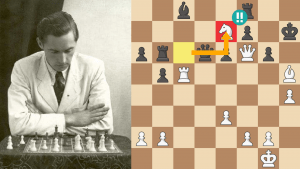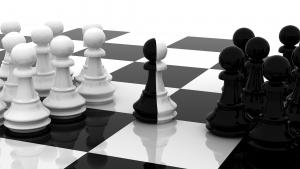
No Balance, No Success
I get countless questions that ask about taste in chess (No, don’t eat the pieces!). Taste, in this case, refers to a preference for positional or tactical situations.
(However, if you MUST eat the pieces, please buy a chess cake or a chess set made out of white and dark/milk chocolate. Wooden pieces are a bad idea since the splinters you’ll get between your teeth are hell. I’ve never tried to eat the plastic pieces but I’m sure it would be disgusting.)
Players want to know if their openings should also meld with their tastes, and if studying tactics and only tactics will get them to the lofty levels (usually expert or master) they dream of.

To illustrate the angst that so many chess players go through, some variation of this “tactics or positional?” query reaches my Chess.com messages and my private email many, many times a week.
Though it’s great (and important!) to study tactics, you risk being a one-trick pony if you look for a combination on every move. Yes, beginners will fall victim to basic tactics over and over again. But once you start facing more experienced opponents you’ll find that your obvious tricks will be laughed at and you’ll lose game after game without really knowing why.
So, let’s highlight a very important rule:
TACTICS USUALLY APPEAR FROM A STRATEGICALLY SUPERIOR POSITION
No tricks, no crossing your fingers, no lapsing into prayer (Do you really believe that whatever deity you worship loves you more than your opponent?), and no constant calculation when you have no idea what’s really going on in the position.
Depending on all this stuff will leave your chess game stillborn; you’ll be dead and buried and you won’t even know it!
Please remember that this article is for players who want to improve and be the best they can be. If you’re happy playing friends who are worse than or equal to your level, then continue doing so and have a great time. First and foremost, chess should be fun.
Okay, it’s time to cut to the chase: if you really want to enjoy chess at levels you never before could, and if you want to improve your results, you need to embrace BALANCE. By all means, make sure you know all the basic tactical and attacking patterns. But also make sure that you mix in a good dose of positional acumen too, since each one bolsters the other.
In this series I’m going to show you that everyone from 2100 onwards has some degree of balance. And the more you learn about the tactics/positional balance, the stronger you’ll get. If your dream is to become a strong expert or master (and who doesn’t want to reach hose heights?) then balance is a must.

I’ll start with my own road to balance. After learning how to play at age 12, I fell in love with raw attackers: Alekhine was my first hero, and other attackers like Rudolf Spielmann, Frank Marshall, and David Janowski followed. Then I turned my attention to all the amazing players from the Romantic era (Adolf Anderssen, Paul Morphy, Joseph Blackburne, Ignaz Kolisch, Mikhail Chigorin, etc.).
After going over the games of these tactical giants, I played some gambit openings, went for the throat (not caring if it was the right or wrong thing to do), and (after I failed more often than succeeded) suddenly realized that even my tactical heroes were demonstrating positional skills when “brute force trauma” didn’t work. So -- back to the drawing board!
I started studying the positional greats too, like Emanuel Lasker (well… his style was a mix of all things), Jose Capablanca, Mikhail Botvinnik, Vasily Smyslov, Tigran Petrosian, and others. And, though I still loved wiping people out with a nice combination, I decided that a brilliant positional concept was even more beautiful.
Here, of course, we have a matter of taste. You might prefer a tactical smack down, but you will still need to depend on your positional tools (and vice versa).
A lifelong 1.e4 player, I switched to 1.d4 at the age of 25 (still lots of sharp lines, but it seemed to offer richer positions) and never looked back.
Here is a simple example of balance:
Our first example is a lovely game where White stops all of Black’s counterplay. Once the opponent (in this case a very strong master) is helpless, White cracks the queenside open and ends his opponent’s suffering.
To me, leaving the opponent bound and whimpering and waiting to die is as good as it can get. But when the position calls for sacrifices the need for balance shows itself -- if the board insists on tactics and violence, then that’s what you have to do. Once again: it has nothing to do with taste and everything to do with obeying the position's needs.
This “I love one kind of position but if a different position arises I’ll also have it covered” mentality can be seen in every master’s game. Here’s a game of the great Rudolf Spielmann taking down the legendary Akiba Rubinstein:
A powerful execution of (at that time) the number-two or -three player in the world (Emanuel Lasker was top dog, with Capablanca and Rubinstein fighting for the next spot).

Allow me a short digression:
San Sebastian is a place teeming with chess history. Decades ago I was driving around Spain and decided that I simply had to stop at San Sebastian and inhale the chess vapors that surely permeated the San Sebastian air. I glanced at my map and off I went. And I drove and I drove and I drove until it was pitch dark with no true city in view. Then, finally, a sign! “Sant Sebastia.”
I had driven to a completely different part of Spain and, instead of the wonders of San Sebastian, I found myself in some unknown (to me) beach town. DOH! I never did make it to San Sebastian.
Sorry about that! Back to Spielmann:
In the mid 1920s Spielmann was one of the top five players in the world. However, when it came to the “big guys,” Alekhine and Capablanca, his all-or-nothing attacks just didn’t get the job done and the only way he was able to score points against them was to switch to positional chess mixed with serious endgame skill!
His life score against Alekhine was several draws, four losses, and two wins. Minus-two against Alekhine was nothing to be ashamed of!
Oddly, he did even better against Capablanca, scoring two wins, two losses, and eight draws! Very few had an even score against Capablanca. Here’s one of his wins against the “chess machine.”
A smooth positional victory. Spielmann made it look easy!
TO SUM UP
- DO study tactics! Make sure you learn all the basic tactical and attacking patterns.
- ALSO study positional concepts (space, weak pawns, the dance of the minor pieces, dynamics vs. statics, the utilization of holes, etc.).
- Balance allows you to follow master games in a whole new light. Suddenly you’ll understand things that, in the past, were invisible.
- Create an opening repertoire that suits your tastes. For example, if you prefer attacking chess, play openings that lend themselves to that credo. However, one never knows which way a game might go. If you can’t step away from your attacking hopes and make use of the positional plusses your opponent gave you (or positional plusses that you created on your own), life will be dark, dreary, and devoid of joy.
- If you love controlling the board and playing in a positional manner, tactics will almost always appear in one form of another. A strong positional player with no tactical bullets is doomed to wallow in endless suffering.
- Supermodels (male and female) love chess players who have mastered balance. Thus, no balance, no supermodels for you.






